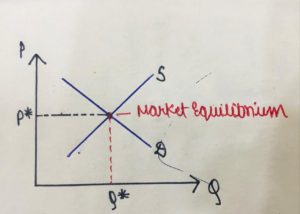Consumer Centric Laws: A Boon or a Bane for the Economy?

– Srishti Nigam & Snehil Ajmera
Introduction
Economics analysis of law is the application of the tools of microeconomic theory to the legal rules and institutions’ analysis. Each and every existing law in the society must ideally be backed by sound economical reasoning. Bentham laid the foundation of the field of economic analysis of law, to get an understanding of the response of the actors to legal incentives. Economics is now applied to multiple areas of non-market regulations such as civil and criminal procedure, arbitration, family law, contract law, law of torts, property laws, consumer protection laws, law enforcements, judicial administration, legal precedents, etc. Consumer protection laws prevent consumers from any kind of fraud and unfair practices but the authors would analyse that excess of anything is always unfavourable just like some provisions in Consumer Protection Act, 2019.
Salient Provisions of Consumer Protection Act, 2019
Before the enactment of the Consumer Protection Act, 2019 there was no specific provision related to the product liability which has made the recent Act more consumer-centric. The authorities relied on the case of Donoghue v. Stevenson which lays down the criteria that irrespective of the contractual relationships, one person owes a duty of care to another and any breach of that duty amounts to negligence.
Consumer Protection laws come into picture when there is an imbalance in the power between the seller and the buyer. With the established trend of laws for the protection of the consumers, consumer’s side weighs more in terms of rights than that of the seller/manufacturer. Consumer protection laws guide the consumer in a particular way and prevent them from making choices which can lead them to results that can be dangerous in nature. According to Sec. 18(1) of the Act, Central Authority shall always protect the interest of the consumers and must look into the fact there are no false or fraud advertisements which can mislead the consumers. Sec. 84 of the Act attracts liability on the manufacturer if any of the conditions mentioned under the sub-clauses are fulfilled.
Economic Analysis of Product Liability
The enactment of product liability as a provision gave too much power to the consumer. With too much intervention of the government, the net marginal benefit of interfering with the markets becomes negative. Every law which is made is by the Legislature is tested on the touchstone as to how it is going to affect the economy at large. Analysing the provisions of consumer protection law through the tools of economics will make the things clearer as to why or why not this law should be more inclined towards the consumer or not.
Each and everything in the economics is tested on the basis of Cost-Benefit Analysis. Cost-Benefit analysis is a procedure which is used to calculate the expected costs and benefits that may be the result of any activity. The objective of applying cost-benefit analysis is to ascertain how sound the economic reasoning of any law is. If the cost side weighs more in any activity/law than the benefit side then it is not considered to be a favourable one; and if benefit side weighs more than the cost side then there is a green flag to proceed with the same as it is a favourable outcome.

Figure 1: Cost-Benefit Analysis
Market is of utmost importance in consumer protection laws. A market in economics is considered as ‘a place where buyer and seller meet to exchange the goods for money.’Market equilibrium has two factors in it i.e. demand and supply, and when the demand is equal to the supply then the market is said to strikeequilibrium. The change in the demand and supply in any market will affect the price and quantity of the product.

Figure 2: Market Equilibrium
As one can easily understand by the bare reading of the Act that the consumer protection laws are consumer centric and are stringent in nature. The stringent nature of laws will make the consumer to place more trust on the producer/seller because the consumer is aware of the fact that if the producer will breach or infringe his rights then the liability would totally fall on him. The considerate amount of trust on the producer by the buyer would increase the demand of the products from the side of the buyer and the demand curve would shift towards its right as it is a case of high demand.
The rightward shift in the demand curve makes it clear that stringent consumer protection laws are increasing the demand from the side of the consumer but on the contrary there is a negative shift in the supply curve as there is decrease in the side of supply.

Figure 3: Negative shift in the Supply Side
The rigorous provisions like Chapters VI & VII in the Act cast the liability on the producer which he cannot escape in any manner. Even if the producer does not know of the defect in the product, according to the sections like 83, 84, 85 and 86 he can be made liable under these provisions. Producer terrified by the harsh laws may decrease the manufacturing and supply of the products which shift the supply curve towards its left which indicates the decrease in the supply level of the products.
When the shifting in the demand curve and supply curve happens due to the presence of rigorous laws, an eye catching thing is that the shift in the supply curve is comparatively more than that of the in the demand curve. The shift in the demand and supply curve out-turns that the equilibrium price and equilibrium quantity are now revamped. The shifts of the demand and supply curves results in an increase in equilibrium price and decrease in equilibrium quantity. The increase in the price of the commodity will lead to inflation. The decrease in the quantity of the production would give a fair chance to unemployment to creep into our economy. The roots of unemployment are inimical for the growth and development of the Indian society at large.

Figure 4: Change in supply and demand side affecting price and quantity
Conclusion & Way Forward
In order to avoid the consumer centric laws becoming bane for the economy, Government of India before enacting the laws like Consumer Protection Act, 2019 should take into consideration the widest impact of such laws on the economy in both short run and long run production. For attracting the social and political benefit such laws must be evaluated through the lens of economics. There should always be a balance between the cost and benefit in order to achieve the economic benefit for the country.
When the government brings a law which is consumer centric in its nature then it would lose the faith of the producers. The producer would not want to produce anything new because of the stringent provisions like Product Liability. In order to retain the faith of both the consumers and producers, the government should provide some incentive to the producer to produce. In order to stop the monopoly, there should be sufficient number of producers in the market. The presence of producers, inspite of the consumer centric laws can only be ensured by giving the right amount of incentive to them. The best incentive for the producer can be the subsidy rovided by the government. The incentive can only be provided in the short run as in the long run production the cost of production may decrease with economies of scale, and thus the subsidies can be taken off by the government.
Mass education is also very necessary in today’s world. Information should reach on both the ends. The consumer as well as the producer should by duly aware of the rights and liabilities flowing from the different legislations enacted in India. To conclude, the government must always ensure that “the effect of shift in the supply curve due to harsh laws on producers and increased product liability on manufacturers is always less than the cumulative effect of technological development and the economics of information otherwise enacting such laws would have an adverse impact on the economic growth.” Nothing can have a more powerful impact on the producers than the demand for quality products by quality-conscious domestic consumers so it becomes the need of the hour that consumers who are likely to claim remedies under this Act should be well versed with the provisions, their rights, and liabilities. In order to achieve this government needs to spread the roots of knowledge to every end by organising events and camps to make consumers aware.
This article is authored by Srishti Nigam & Snehil Ajmera. They are students of law at Maharashtra National Law University, Nagpur.